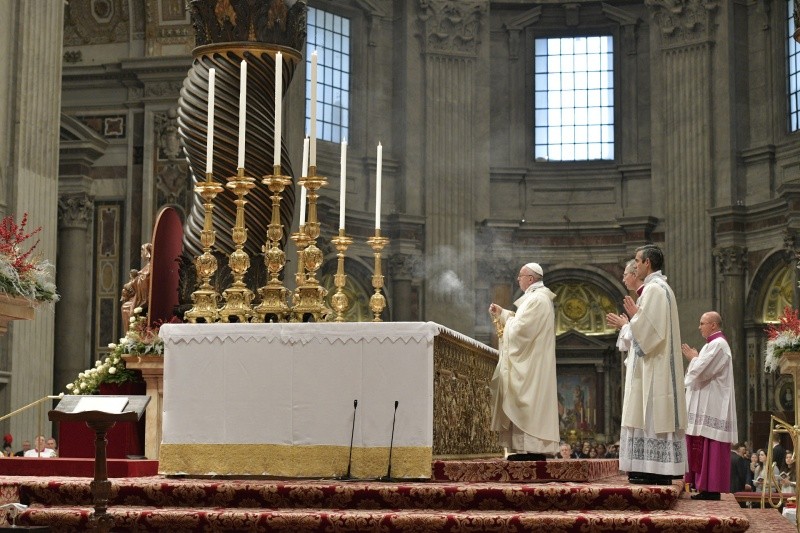Answered by Legionary of Christ Father Edward McNamara, professor of liturgy and dean of theology at the Regina Apostolorum university.
Q: According to the Ceremonial of Bishops, No. 73, when the bishop presides at a solemn celebration of vespers or morning prayer, he kisses the altar at the beginning and, as circumstances suggest, at the end. [Liturgist] Peter Elliott extends this to all celebrants and deacons. Is that correct? — T.S., Aberdeen, Scotland
A: What now Bishop Peter Elliott says in his important work Ceremonies of the Modern Roman Rite is the following when addressing the question of the liturgy of the hours:
“… Having made the customary reverence, the celebrant and his assistant deacon(s) or priests go up to the altar and kiss it. Then they go to the presidential chair.”
I would agree with Bishop Elliott that this is the correct procedure. Also, although he does not address the issue as such, I would say that it would be the same if a deacon presides at vespers in the absence of a priest.
The reason for possible doubt is precisely the dearth of clear instructions regarding the initial part of the office in Chapter 5 of the General Instruction of the Liturgy of the Hours, Nos. 254-266.
This difficulty of lack of precision was also present in the first editions of the new missal.
In fact, the detailed descriptions found in the Ceremonial of Bishops were an attempt to remedy this and to find a middle way between the meticulous rubrics of the extraordinary form and the overly generic ones of the more recent liturgical books.
In this way the Ceremonial of Bishops, while retaining its primary characteristic as a book for bishops, would provide sound guidance for priests in doubtful cases not clear in the other books.
This was not always appreciated. Many years ago I was privileged with access to a document from the archives of the discussion surrounding the preparation and approval of the Ceremonial of Bishops in the 1970s. One prelate criticized the book as being redolent of a pre-Vatican II mentality, another, the cardinal archbishop of Krakow, Karol Wojtyla, defended it as a necessary document as there was much confusion regarding these themes.
Because of the clarifying function of the Ceremonial of Bishop it is widely used by liturgists to address questions left unanswered in other sources. This, I presume, is why Bishop Elliott proposes the legitimacy of extending the bishops’ norms to the priest. As I mentioned, I agree on this point.
The most recent edition of the Roman Missal has far clearer rubrics and is thus the primary source with respect to the Mass. In cases where the norms of the missal differ slightly from those of the ceremonial, the missal has precedence except when dealing with something that is exclusive to the functions of the bishop.
For example, following the publication of the ceremonial many priests would remain seated while putting incense in the thurible and blessing the deacon as indicated in the ceremonial. The missal is silent on this point.
However, it had been customary that only a bishop would sit while preforming certain ceremonies, and thus the third edition has indirectly clarified that priests should stand for these functions.
It does so in two moments:
“131. After this, all rise, and the Alleluia or other chant is sung as the liturgical time requires (cf. nos. 62-64). …
“212. During the Liturgy of the Word, the concelebrants remain at their places, sitting or standing whenever the principal celebrant does. When the Alleluia is begun, all rise, except for a Bishop, who puts incense into the thurible without saying anything and blesses the Deacon or, in the absence of a Deacon, the concelebrant who is to proclaim the Gospel. However, in a concelebration where a Priest presides, the concelebrant who in the absence of a Deacon proclaims the Gospel neither requests nor receives the blessing of the principal celebrant.”
Given that the expression “all rise” means all, and that the exception mentioned about the bishop is one of the very few times something specific to the bishop is mentioned in the GIRM, I surmise that this was an intentional clarification of the proper posture of the priest at this moment. If it were intended that the priest remain seated, No. 131 would indicate it.
With respect to the Divine Office, the Ceremonial of Bishops is still of essential value as there have been relatively few clarifications of the ceremonial aspects since its publication.
* * *
Readers may send questions to zenit.liturgy@gmail.com. Please put the word «Liturgy» in the subject field. The text should include your initials, your city and your state, province or country. Father McNamara can only answer a small selection of the great number of questions that arrive.

© L'Osservatore Romano
Reverencing the Altar at the Liturgy of the Hours
Seems Fitting That All Clergy Present Do It


